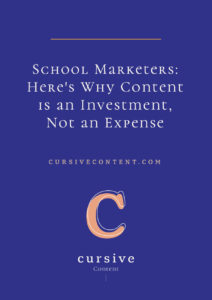School Marketers: Here’s Why Content is an Investment, Not an Expense

My three-year-old has a pink polka-dotted piggybank that sits on her shelf, filled with quarters earned from a bed made or a mess cleaned.
She hasn’t yet spent a dime. She’s waiting to pick the perfect toy – afraid today’s princess doll won’t be as awesome as tomorrow’s selection of Legos. So she sits quietly, counting and stacking her loot, carefully adding each coin back into the bank.
Clink. Clink.
Can’t we all relate?
There’s something seductive and satisfying about filling your piggybank to the brim, until the quarters are so tightly packed that the clinking is silenced.
But there’s a difference between emptying out that piggybank for a doll you’ll play with once or twice, and purchasing a box of awesome Legos that you can continuously use to build new things.
It’s the age-old conundrum of investment vs. expense. And it’s something school marketers need to continually weigh.
Investment: An act of devoting time, effort, or energy to a particular undertaking with the expectation of a worthwhile result.*
Expense: A thing on which one is required to spend money.*
Too often, marketing, in general, is considered a necessary evil expense that schools feel obligated to spend money on but are skeptical of the results.
And that’s why corner-cutting is so prevalent. Yes, we need to spend money on marketing, but do we need to pay them to develop content too? Can’t we do that in house?
The truth? Marketing without strategy is an expense.
Marketing without knowing, understanding or focusing on the results you are expecting can simply drain your budget and get you little to nothing in return.
The difference is strategy. And content is a critical component of successful marketing strategies.
Why? The content of your marketing campaign is where you prove your marketing claims. It’s where you build confidence in your abilities and expertise. It’s where you demonstrate a deeper knowledge than possible in a catchy headline or clever tagline.
It’s time to stop thinking of content as an expense and start seeing it as an investment. And here’s why:
You own it.
If you are creating content that supports your school story and helps demonstrate your expertise, it is an asset you own, forever. If this content lives on a blog or website, that content hub is yours to control – unlike social media platforms that can change their rules and reach overnight.
You develop it once and repurpose it forever.
Great evergreen content that answers your dream families’ questions or concerns today will still be relevant long into the future. Once you create a robust and diverse content platform, it’s easy to update and maintain. You can turn an article into a blog post and a video and an infographic and a webinar and … you get the point. Good content is flexible. Great content is a contortionist.
It continues to drive traffic over time.
A smart article that is appealing to readers will attract audiences way beyond its initial publication date. If your content is online, it can be easily found by prospects whenever that issue is relevant to their situation, making you the answer to their needs at their critical decision-making moments.
You are investing in your leaders and their expertise.
If your content strategy incorporates your school leaders and faculty, you are giving them a way to sharpen their own points of view, strengthen their communication skills and build their online authority. By enhancing the authority of your leaders, you are enhancing the authority of your school.
It helps you develop your own school voice.
If you’re not developing content, it’s difficult to create a coherent school voice, tone and personality. By writing, editing and reviewing branded content, you will begin to understand the authentic voice, story and perspective behind your school brand. It will help bring life into your school story and allow you to connect with current and prospective students and families on a more intimate, personal level.
So the next time you’re thinking about cutting the content line item to save a few pennies, think again. Consider the investment you’re making in your school, your employees, your ongoing marketing – and your own authority. And script your story right.
What do you think — is content an investment worth making? Join the conversation in the comments below.
MORE ARTICLES
-
 Clarity in 50 Words or Less: How to Write Your School’s One-Sentence Story
Clarity in 50 Words or Less: How to Write Your School’s One-Sentence Story -
 The 4 Building Blocks of a Strong School Story (and Why AI Needs Them)
The 4 Building Blocks of a Strong School Story (and Why AI Needs Them) -
 How to Stop ChatGPT from Making Your School Sound Generic
How to Stop ChatGPT from Making Your School Sound Generic -
 What Should Your School Do with Its Blog Now That AI Is Changing Search?
What Should Your School Do with Its Blog Now That AI Is Changing Search? -
 What Is Your Private School’s Bold & Unifying Big Promise?
What Is Your Private School’s Bold & Unifying Big Promise? -
 Viewbook Best Practices for Private Schools
Viewbook Best Practices for Private Schools -
 AI Writing Prompts to Power Private School Storytelling
AI Writing Prompts to Power Private School Storytelling -
 When to Outsource Your Private School Content Marketing to an Expert
When to Outsource Your Private School Content Marketing to an Expert
